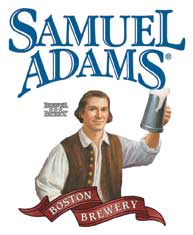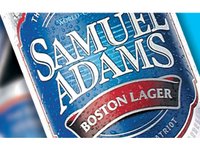I don't mind crowds, but this seemed mainly like a problem with design. Besides the beer, there is a whole section of the space devoted to arts and crafts vendors. This may have made sense five years ago, but it's a disaster now. (In your mind's eye, envision Pioneer Courthouse Square. Now envision Waterfront Park. Now take all the festgoers from the OBF and cram them into Pio Sqaure. Now add a flea market. You see, the physics are starting to work against us.) I actually like some of the vendors--it gives you a little something to do while you're ducking from the throngs. But with the growing sophistication and popularity of big, complex beers, there's just not room for it all.
One other gripe: more beer. When I arrived at 1:30, four beers were already blown (this is two and a half hours into an eleven hour fest). By midafternoon, the majority were blown. In my preview, I mentioned several international beers--all of these were either blown by the time I arrived or within minutes after I got there. No Samichlaus for me. So, recognize that this is a bigger fest than it used to be and make changes. Okay, enough on that.
The Beer
As I expected, the beer was almost uniformly terrific. Parsing the merely good from the excellent is a fool's errand and I'll avoid it. There were a couple beers that stood out, so I'll highlight those, and the rest I'll just include a few of my notes. (They were sparse and erratic this year not because of what I'd drunk, but because there was precious little room to jot notes.)
Believer - Ninkasi Brewing
 This was my first beer and I think managed to take all comers and emerge as my fave. It had one of the most succulent aromas I've ever encountered--sweet, citrusy, with a little mint. I had four people give it a sniff and they all did the same thing: sniff, eyebrows up, head back down for another sniff. The palate was every bit as good. Although it was a lighter beer, it was one of the few that really said Christmas--it had a touch of pine, sweetness, and warmth. I wish this were available at every pub in Portland. (At right is a picture of Jamie Floyd that I stole from Belmont Station's blog.)
This was my first beer and I think managed to take all comers and emerge as my fave. It had one of the most succulent aromas I've ever encountered--sweet, citrusy, with a little mint. I had four people give it a sniff and they all did the same thing: sniff, eyebrows up, head back down for another sniff. The palate was every bit as good. Although it was a lighter beer, it was one of the few that really said Christmas--it had a touch of pine, sweetness, and warmth. I wish this were available at every pub in Portland. (At right is a picture of Jamie Floyd that I stole from Belmont Station's blog.)Cabin Fever (Stout) - Klamath Basin Brewing
A close second was the fest's only stout. It seemed like a sweet stout with a heavy dose of lactose--sort of a beery equivalent of hot chocolate. It was rich and super creamy and seemed to have the essence of wholesome milk blended in. I love it when a brewery I've never tried before knocks my socks off. Klamath Falls now has two good breweries--not bad for a small town.
Regifted Red - Widmer
Aggressive and alcoholic. Reminded me of the Seasonal red they do (maybe that's the "regift," but with more oomph.
Blizzard of Ozz - Off the Rail Brewing
This is the one beer I found substandard. Somewhat funky and mildewy tasting. I think it was supposed to be a smooth toddy-style winter, ala Tannen Bomb.
Strong Scotch - Fearless Brewing
A good beer, but it didn't seem strong. (Looking at the brochure now, I see that it was 8.5%, and I'm shocked--it seemed half that.) I wrote "Great Scotch ale, wonderfully malty, but quite light. a 60 Shilling, not a wee heavy." Goes to show I don't know what the hell I'm talking about.
Blitzen (tripel) - Rock Bottom Brewery
Long ago there was a chain restaurant in downtown Portland with a theme--they all have themes--of beer. You could get cute little ales that tasted like soda with your mediocre food. It was so popular people packed the joint. It was the one brewery in Oregon I never wrote about when I was writting for Celebrator and Willamette Week, because I refused to recognize it as a brewery. (They were pissed, but they would have been more so if I actually wrote about their beers.) Well, all that has changed. They brew real beers now, and I actually go out of my way to try them. This offering is a very tough style, and even good examples suffer by not having the complexity you'd find in a brewery with a 200-year-old yeast strain. That said, this was one of the best American examples I've had, with a complex recipe and decent yeast character. The head was remarkable, too--like whipped cream.
Full House - Pelican
In the Wassail/Jubel continuum of winter ales--rich, hoppy, strong, and tasty.
Jim K. - Hair of the Dog
Much has already been written about this beer, so allow me to be brief, since I wouldn't know what else to add in any case. It is a beer with great character from the nose to the aftertaste that seems to alternate among its various elements, seemingly emphasizing a sweet/sour note one moment and an old-fashioned hard candy note the next. I've never seen people respond to a beer like people responded to this. I'd love to see it come on the market and observe whether it was the festival atmosphere or the beer itself.
Cuvée de Noël - St. Feuillien
No notes on this one. I recall that it emphasized the malts and was smoother and less complex than I expected. A gentler winter warmer.
I also had sips of various other beers and so got a sense of a broader range, but for the sake of journalistic integrity, I won't presume that these were adequate samples. That's it until next year--




 In the glass, Boston Lager looks quite a lot like a scotch. Not so much when you pour it out--then it's a rich amber with a vigorous bead. But if you, as I did, accidentally leave an inch in your glass until the head and fizz have passed and the beer has become still, you could easily mistake it for Cragganmore. (Or is it Oban I'm thinking of? Nevermind.)
In the glass, Boston Lager looks quite a lot like a scotch. Not so much when you pour it out--then it's a rich amber with a vigorous bead. But if you, as I did, accidentally leave an inch in your glass until the head and fizz have passed and the beer has become still, you could easily mistake it for Cragganmore. (Or is it Oban I'm thinking of? Nevermind.)